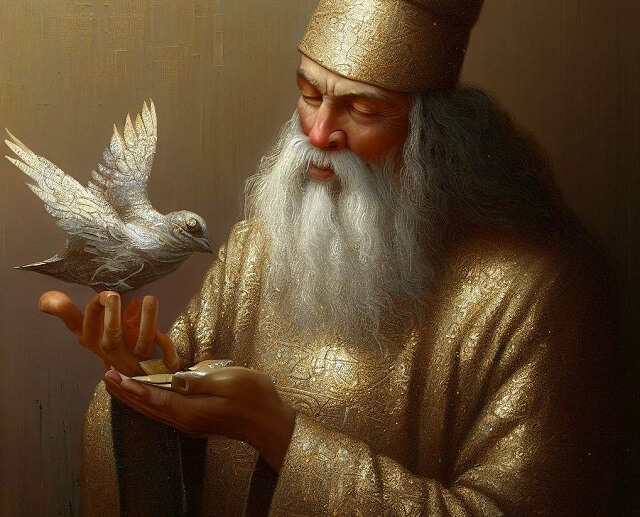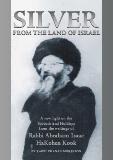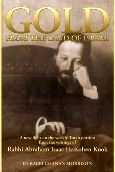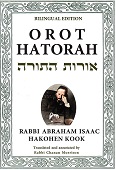
The psalmist poetically compares the Jewish people to a beautiful dove:
“Wings of the dove, covered with silver, and her pinions with shimmering gold.” (Psalms 68:14)
What is the significance of this metaphoric dove, with wings of silver and gold?
The Punctilious Scholar
The Talmud (Berachot 53b) relates that Rabbah bar bar Hannah was once traveling with a caravan. The fourth-century Babylonian scholar ate at a rest stop, but only remembered that he had not recited Birkat Hamazon (grace after meals) after the convoy had already continued on its journey.
Rabbah wanted to return to the location of his meal in order to recite Birkat Hamazon there. But he thought to himself: If I tell them to go back because I forgot the blessing, they will say, “Just recite it here; after all, anywhere you pray, God hears you.” Better I should tell them that I left behind a valuable golden dove.
That is what the rabbi did. Convinced of the importance of going back, the entire group returned to the spot, and Rabbah was able to recite Birkat Hamazon in the place he had eaten.
And then, perhaps as a reward for his diligence in performing mitzvot, Rabbah bar bar Hannah found there a golden dove.
Is there some connection between grace after meals and the golden dove?
Two Attitudes towards Mitzvot
Different people have different attitudes toward mitzvot. Most people recognize that fulfilling mitzvot instills an overall mindset that we are serving our Creator. They do not grasp, however, the importance of detailed halachot and minutiae of mitzvot. As the Sages noted, “An ignoramus cannot be pious” (Avot 2:5). It was obvious to Rabbah bar bar Hannah that his fellow travelers would react by saying, “Anywhere you pray, God hears you.” They would not understand the importance of reciting Birkat Hamazon in the proper place.
The wise individual, on the other hand, recognizes the value of mitzvot in their powerful influence on our lives. Each fine detail is designed with sublime wisdom, contributing to the mitzvah’s overall impact.
What is the significance of the golden dove? Rabbah understood that when we recite Birkat Hamazon in the location where we ate, we are performing a powerful spiritual act precisely where we were most deeply involved in materialistic pursuits. Elevating the physical aspects of life is like mining gold from the very depths of the earth and giving it wings to fly higher and higher. Rabbah was able to capture this concept of enabling the material to fly with the metaphor of a “dove of gold.”
Why a Dove?
Nonetheless, Rabbah could have spoken of any golden bird. Why did it have to be a dove? The Talmud explains that the dove symbolizes the Jewish people. Understanding the symbol of the dove will shed light on how mitzvot make an impact on the Jewish people.
The verse speaks of wings that are “covered in silver,” while the inner pinions are “shimmering gold.” What is the significance of gold and silver here?
The pinions are the bird’s powerful inner organs that drive its outer wings. Just as the dove’s flying limbs have internal and external parts, so too, mitzvot have internal and external aspects. The inner purpose of each mitzvah is like a muscular pinion, the central force that powers the wings.
The verse describes the pinions as golden, a rare metal used primarily by kings and noblemen (“All of King Solomon’s drinking vessels were of gold” (I Kings 10:21)). This indicates that the inner purpose of mitzvot is known only to the select few, the truly great scholars.
The outer wings, on the other hand, are covered in silver, a more common metal. This distinction between golden pinions and silver wings corresponds to the inner purpose of mitzvot, as grasped by great scholars, and their outer expression, applicable to everyone. But it is important to remember that the pinions and wings form an integrated mechanism, working together. Just as the inner pinions provide the power for the wings, so too, the inner meaning of mitzvot is expressed in external actions. The interconnectedness of the dove’s pinions and wings symbolizes how mitzvot benefit all sectors of the nation.
Rabbah bar bar Hannah specifically spoke of a dove to allude to this integrated aspect of mitzvot. He knew that his understanding of the mitzvah of Birkat Hamazon was on a deeper level than the other travelers. Yet he wished to express the relevance of mitzvot to all Jews, whether they are able to appreciate their inner purpose or not.
Rescuing the Soul
The Talmud gives an additional explanation of the metaphor of the dove and its connection to the Jewish people:
“Just as the dove saves itself through its wings, so too, the Jewish people are saved by virtue of their mitzvot.”
The dove relies on its wings to flee. Danger awakens the dove to fly away, to raise itself up from its lowly state. So, too, when the Jewish people are beset by materialism, when they are overwhelmed by the physical aspects of life, the inner soul is pained. The troubled soul, yearning for divine goodness and nobility, is rescued and elevated via mitzvot.
Interestingly, it is precisely the feelings of emptiness caused by the descent into the depths of physicality that awaken our inner need for spirituality. This idea helps us understand why Birkat Hamazon should be recited where one eats. Immersion in physical pleasures when eating is disconcerting to the holy soul; it is rectified by the spiritual elevation gained when reciting Birkat Hamazon.
(Adapted from Ein Eyah vol. II pp. 241-242)





